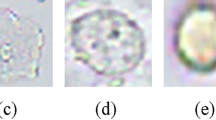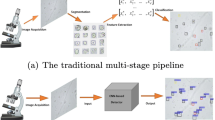Abstract
Urine sediment examination refers to the use of microscopes to examine various tangible components in urine sediment, e.g. red blood cells (RBCs), white blood cells (WBCs), tube, and crystal, etc., having a very important role in infectious diseases and circulatory diseases diagnosis. The traditional method about urine sediment analysis depends on the observation of medical staffs. So the workload is particularly large and inefficient, and relevant staff need to own some experience. Recently, the automation of urine sediment analysis can be realized. However, due to the complexity of the urine sediment microscopic image, the accuracy and efficiency of the automatic recognition for the tangible components are still very low. To solve this problem, we investigate channel features to urine sediment detection which include diverse feature types like color channel features and gradient magnitude, etc. We propose aggregate channel features plus (ACF+) detector which is based on aggregate channel features (ACF) for urine sediment detection. We adopt improved Adaboost classifier. The input image does not require any preprocessing and the specific ingredients such as RBCs can be detected directly with a high precision and efficiency. On the testing set, our proposed ACF+ detector suppresses several competitive baselines e.g. Support Vector Machine (SVM) combined with Histogram of Oriented Gradient (HOG), vanilla ACF, and ACDS. In terms of speed, it runs 3FPS on 2592 × 2048 images.





Similar content being viewed by others
References
Bourdev L, Brandt J (2005) Robust object detection via soft cascade, in Computer Vision and Pattern Recognition, 2005. CVPR 2005. IEEE Computer Society Conference on, vol. 2. IEEE, pp. 236–243
Canny J (1986) A computational approach to edge detection. IEEE Trans Pattern Anal Mach Intell PAMI-8(6):679–698
Cao G, Zhong C, Li L, Dong J (2009) Detection of red blood cell in urine micrograph, in Bioinformatics and Biomedical Engineering, 2009. ICBBE 2009. 3rd International Conference on. IEEE, pp. 1–4
Comaniciu D, Meer P (2002) Mean shift: a robust approach toward feature space analysis. IEEE Trans Pattern Anal Mach Intell 24(5):603–619
Cortes C, Vapnik V (1995) Support vector machine. Mach Learn 20(3):273–297
Dalal N, Triggs B (2005) Histograms of oriented gradients for human detection, in Computer Vision and Pattern Recognition, 2005. CVPR 2005. IEEE Computer Society Conference on, vol. 1. IEEE, pp. 886–893
Dollar P, Tu Z, Perona P, Belongie S (2009) Integral´ channel features
Dollar P, Appel R, Belongie S, Perona P (2014) Fast fea-´ ture pyramids for object detection. IEEE Trans Pattern Anal Mach Intell 36(8):1532–1545
Dong L, Yuan S, Liu G, Zhou L, Li Y (2007) Classification of urinary sediments image based on bayesian classifier, in Mechatronics and Automation. ICMA 2007. International Conference on. IEEE, 2007, pp. 556–560
Friedman J, Hastie T, Tibshirani R et al (2000) Additive logistic regression: a statistical view of boosting. Ann Stat 28(2):337–407
Fukunaga K, Hostetler L (1975) The estimation of the gradient of a density function, with applications in pattern recognition. IEEE Trans Inf Theory 21(1):32–40
Goldberg M, Zhang J (1987) Hierarchical segmentation using a composite criterion for remotely sensed imagery. Photogrammetria 42(3):87–96
Han L, Le THN, Savvides M (2017) An automatic cells detection and segmentation, in SPIE Medical Imaging. International Society for Optics and Photonics, pp. 101370W–101370W
Jiang X, Nie S, (2007) Urine sediment image segmentation based on level set and Mumford-shah model, in Bioinformatics and Biomedical Engineering, 2007. ICBBE 2007. The 1st International Conference on. IEEE, pp. 1028–1030
Li Y-C, Li Z-C, Mei Y-H, and Zhang J-X (2005) Detecting algorithm based gabor in microscopic image, in Machine Learning and Cybernetics. Proceedings of 2005 International Conference on, vol. 9. IEEE, 2005, pp. 5410–5415
Li C, Xu C, Gui C, Fox MD (2010) Distance regularized level set evolution and its application to image segmentation. IEEE Trans Image Process 19(12):3243–3254
Ohtsu N (1980) An automatic threshold selection method based on discriminate and least squares criteria. Transactions of the Institute of Electronics and Communication Engineering of Japan, D 63(4):349–356
Paranjape AS, Castleman K, Milner TE, Rylander G (2007) advanced imaging technique for automated classification of casts and crystals in urine, in Biomedical Optics (BiOS) 2007. International Society for Optics and Photonics, pp. 64240X–64240X
Ponce J, Berg T, Everingham M, Forsyth D, Hebert M, Lazebnik S, Marszalek M, Schmid C, Russell B, Torralba A et al. (2006) Dataset issues in object recognition, Toward category-level object recognition, pp. 29–48
Pramotepipop Y, Cheevasuvit F (1988) Modification of split-and-merge algorithm for image segmentation, in Asian Conference on Remote Sens, 9 th, Bangkok, Thailand
Rajaguru H, Bojan VK (2014) Performance analysis of em, svd, and svm classifiers in classification of carcinogenic regions of medical images. Int J Imaging Syst Technol 24(1):16–22
Safavian SR, Landgrebe D (1991) A survey of decision tree classifier methodology. IEEE transactions on systems, man, and cybernetics 21(3):660–674
Tan SC, Lim CP, Harrison RF, Kennedy RL (2014) A new rbfndda-knn network and its application to medical pattern classification, in Soft Computing in Industrial Applications Springer, pp. 71–82
Tangsuksant W, Pintavirooj C, Taertulakarn S, Daochai S (2013) Development algorithm to count blood cells in urine sediment using ann and hough transform, in Biomedical Engineering International Conference (BMEiCON), 2013 6th. IEEE, pp. 1–4
Vincent L, Soille P (1991) Watersheds in digital spaces: an efficient algorithm based on immersion simulations. IEEE Transactions on Pattern Analysis & Machine Intelligence 13(6):583–598
Shen M-l, Zhang R (2009) Urine sediment recognition method based on svm and adaboost, in Computational Intelligence and Software Engineering. CiSE 2009. International Conference on. IEEE, 2009, pp. 1–4
Wang SH, Muhammad K, Lv Y, Sui Y, Han L, Zhang YD (2018) Identification of alcoholism based on wavelet renyi entropy and three-segment encoded jaya algorithm. Complexity 2018(2):1–13
Wang SH, Lv YD, Sui Y, Liu S, Wang SJ, Zhang YD (2018) Alcoholism detection by data augmentation and convolutional neural network with stochastic pooling. J Med Syst 42(1):2
Yang B, Yan J, Lei Z, Li SZ (2014) aggregate channel features for multi-view face detection, in Biometrics (IJCB), 2014 IEEE International Joint Conference on IEEE, pp. 1–8
Acknowledgments
This work was partly supported by National Science Foundation of China under no.61473086, no.61773117 and no. 61603080.
Author information
Authors and Affiliations
Corresponding author
Rights and permissions
About this article
Cite this article
Sun, Q., Yang, S., Sun, C. et al. Exploiting aggregate channel features for urine sediment detection. Multimed Tools Appl 78, 23883–23895 (2019). https://doi.org/10.1007/s11042-018-6241-9
Received:
Revised:
Accepted:
Published:
Issue Date:
DOI: https://doi.org/10.1007/s11042-018-6241-9




